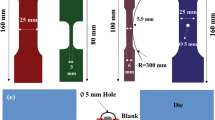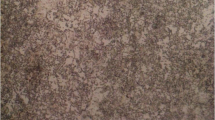Abstract
A double notched central hole, i.e., DNC specimen, which contains a center hole with a left side notch and a right side notch accompanying the slope α, is proposed to simultaneously achieve dual values of stress triaxiality and Lode parameter from one specimen in the present study. Analytical and numerical approaches are carried out under decent assumptions to characterize the plane strain behavior of DNC specimen along with the slope α. Quasi-static tensile tests with conventional specimens and DNC specimens revealed plastic strains at fracture for each specimen case in accordance with stress triaxiality and Lode parameter by digital image correlation. It is found that one DNC specimen successfully provides dual values of stress triaxiality and Lode parameter at the same time; therefore, it saves up to 50 % of experimental time and labor of conventional specimens.
Similar content being viewed by others
References
Y. Dong, X. Wang, Y. Xie, C. Yang and D. Zhou, Tunable microstructures and tensile mechanical properties of oxide-dispersion-strengthened Cu by extrusion and secondary processing, Journal of Alloys and Compounds, 812(5) (2020) 152112.
S. Yan, X. Zhao and W. Aihui, Ductile fracture simulation of constructional steels based on yield-to-fracture stress-strain relationship and micromechanism based fracture criterion, Journal of Structure Engineering, 144(3) (2018) 04018004.
Y. Bai and T. Wierzbicki, A new model of metal plasticity and fracture with pressure and Lode dependence, International Journal of Plasticity, 24(6) (2008) 1071–1096.
G. R. Johnson and W. H. Cook, Fracture characteristics of three metals subjected to various strains, strain rates, temperatures and pressures, Engineering Fracture Mechanics, 21(1) (1985) 31–48.
J. Bardet, Lode dependence for isotropic pressures-sensitive elastoplastic materials, Journal of Applied Mechanics, Transactions ASME, 57(3) (1990) 498–506.
P. Menetrey and K. Willam, Triaxial failure criterion for concrete and its generalization, ACI Structural Journal, 92 (1995) 311–318.
D. Bigoni, A. Piccolroza and C. Viggiani, A new yield function for geomaterials, Constitutive Modeling and Analysis of Boundary Value Problems in Geotechnical Engineering, Hevelius Edizioni srl, Benevento, Italy (2003) 22–24.
Y. Bao and T. Wierzbicki, On fracture locus in the equivalent strain and stress triaxiality space, International Journal of Mechanical Sciences, 46(1) (2004) 81–89.
H. Mae, X. Teng, Y. Bai and T. Wierzbicki, Calibration of ductile fracture properties of a cast aluminum alloy, Materials Science and Engineering A, 45(1–2) (2007) 156–166.
K. Kofiani, A. Nonn and T. Wierzbicki, New calibration method for high and low triaxiality and validation on SENT specimens of API X70, International Journal of Pressure Vessels and Piping, 111–112 (2013) 187–201.
J. Choung, W. Nam, D. Lee and C. Y. Song, Failure strain formualtaion via average stress triaxiality of an EH36 high strength steel, Ocean Engineering, 91 (2014) 218–226.
M. Algarni, Y. Bai and Y. Choi, A study of inconel 718 dependency on stress triaxiality and Lode angle in plastic deformation and ductile fracture, Engineering Fracture Mechanics, 147 (2015) 140–157.
I. Peshekhodov, S. Jiang, M. Vucetic, A. Bouguecha and B.-A. Berhens, Experimental-numerical evaluation of a new butterfly specimen for fracture characterisation of AHSS in a wide range of stress states, IOP Conference Series: Materials Science and Engineering, 159 (2016) 012015.
Y. S. Ma, D. Z. Sun, F. Andrieux and K. S. Zhang, Influences of initial porosity, stress triaxiality and Lode parameter on plastic deformation and ductile fracture, Acta Mechanica Solida Sinica, 30(5) (2017) 493–506.
Y. Bai, X. Teng and T. Wierzbicki, On the application of stress triaxiality formula for plane strain fracture testing, Journal of Engineering Materials and Technology, 131(2) (2009) 021002.
K. Danas and P. P. Castañeda, Influence of the Lode parameter and the stress triaxiality on the failure of elasto-plastic porous materials, International Journal of Solids and Structures, 49(11–12) (2012) 1325–1342.
S. W. Ham and S. S. Cheon, FE Analysis at Design, Internal Report, MDML2020 (2020).
S. H. Crandall, N. C. Dahl, T. J. Lardner and M. S. Sivakumar, An Introduction to Mechanics of Solids, 3rd Ed., McGraw-Hill, Boston, USA (2013).
V. V. Vasiliev and E. V. Morozov, Advanced Mechanics of Composite Materials and Structures, 4th Ed., Elsevier, Amsterdam, Nederland (2018).
P. W. Bridgman, Studies in Large Plastic Flow and Fracture, McGraw-Hill, New York, USA (1952).
J. J. Craig, Introduction to Robotics, 3rd Ed., Pearson Prentice Hall, Upper Saddle River, USA (2005).
N. McCormick and J. Lord, Digital image correlation, Materials Today, 13(12) (2010) 52–54.
Acknowledgments
This work was supported by the research grant of the Kongju National University in 2017.
Author information
Authors and Affiliations
Corresponding author
Additional information
Seok Woo Ham is a Ph.D. student of the Department of Mechanical Engineering, Kongju National University, Cheonan, Korea. His research interests include crashworthiness of automotive, fracture mechanics and application of composite materials.
Jae Ung Cho received his M.S. and Ph.D. in Mechanical Engineering from Inha University, Incheon, Korea, in 1982 and 1986, respectively. Currently, he is a Professor in the Department of Mechanical Engineering at Kongju National University, Korea. He is interested in the areas of fracture mechanics (dynamic impact), composite material, fatigue and strength evaluation, and so on.
Seong S. Cheon received his M.S. and Ph.D. in Mechanical Engineering at KAIST in 1995 and 1999, respectively. He is currently a Professor in the Department of Mechanical Engineering at Kongju National University, Korea. His research interests include crashworthiness of joining parts, mechanical behavior of foams and application of composite materials.
Rights and permissions
About this article
Cite this article
Ham, S.W., Cho, J.U. & Cheon, S.S. Novel specimen for the effective measurement of the fracture strain along with stress triaxiality and Lode parameter. J Mech Sci Technol 35, 3847–3854 (2021). https://doi.org/10.1007/s12206-021-2108-5
Received:
Revised:
Accepted:
Published:
Issue Date:
DOI: https://doi.org/10.1007/s12206-021-2108-5




